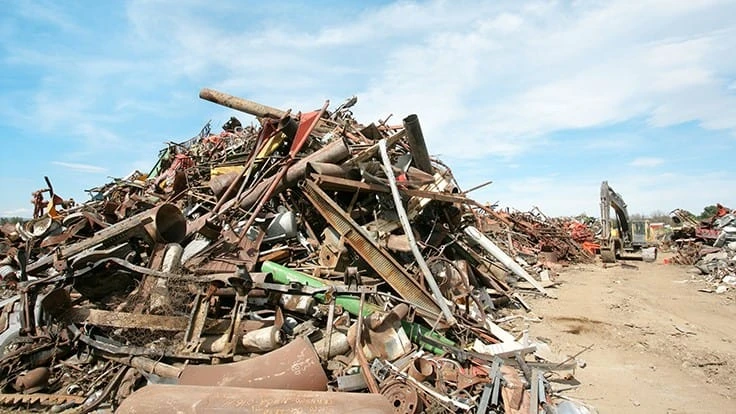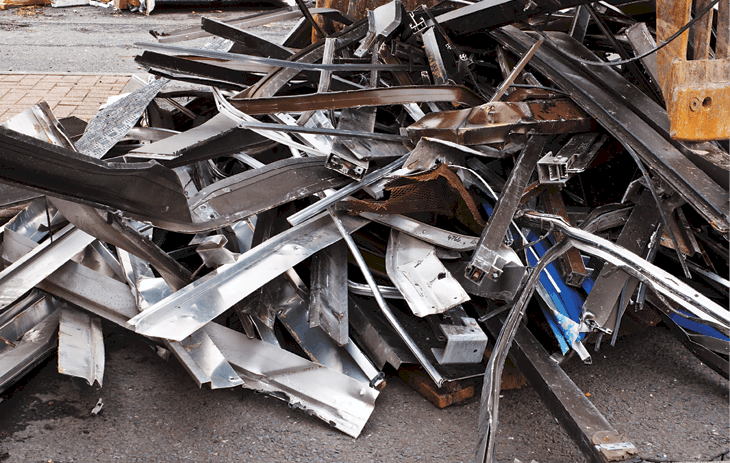
There are a number of considerations that demolition contractors have to be mindful of when taking down a structure. Companies have to prioritize safe and environmentally responsible practices while maximizing efficiency and working to meet the owner’s various demands. But amid the detailed scope of work and rigorous planning that may be required for a given job, one thing that is always top of mind is profitability.
One of the ways companies can help guarantee a strong ROI for a project is by maximizing the metals recovered for recycling.
Drew Lammers, vice president of outside operations for Cohen Recycling, helps demolition contractors do just that.
Lammers, who works hand in hand with contractors to help them strategically plan their metal recycling initiatives in his role at the Middletown, Ohio-based scrap recycling company, is well-acquainted with the demolition side of the business.
Prior to joining Cohen, Lammers was the owner of Cincinnati-based King Wrecking Company. During this tenure, he also served as the National Demolition Association president and in other leadership positions at the association.
According to Lammers, one of the most effective things a contractor can do to derive metal value on the job is focusing on the nonferrous in a structure prior to teardown. While contractors use to try to pick this material during wrecking (and some still do), recovering nonferrous metals prior to the start of structural teardown work can help ensure material is not lost among other debris.
“If there’s an opportunity to go in and get your nonferrous out, or the majority of your nonferrous out before you start tearing a building down, you’ll get greater value because you tend to lose some of that material in your demolition debris after the fact since the majority of it is non-magnetic,” he says. “The dollars today are in nonferrous metals, which are seeing near record highs in terms of value. I think sometimes some demolition contractors are so worried about getting the iron and have the mentality of ‘get the steel, get the steel, get the steel,’ they forget that copper or aluminum or stainless is worth a lot more when it comes to a per pound basis than the steel is.”
Lammers says that even though there might be significantly more ferrous material on a project by volume, the nonferrous can add up to big value due to today’s prices. Additionally, ferrous material is relatively easy to pick from a project since it can be grabbed by a magnet after teardown.
Lammers says common sources of scrap that contractors can identify include items such as aluminum siding, rebar, electrical wire, duct work and HVAC components, structural beams, light fixtures, plumbing, gutters, shutters, railings and overhead doors.
Getting these materials out of a building is the first step, but processing them effectively brings a whole new set of challenges. While processing can often be cumbersome and time-consuming, Lammers says that the work that goes into preparing the material has a direct correlation to the value that can be gleaned from it.
“If you’ve copper wire in today’s market, for example, it might be worth putting it through a stripper to get down to the bare copper because it’s worth more than an insulated wire. Now, there’s labor involved to do that, but contractors have to determine what’s worth it in terms of the ROI,” he says.
Lammers says that even if there are higher value metals in a load, if they’re mixed in with less valuable material, the contractor won’t be able to get as much for it as if it was properly separated. Similarly, if a load is mixed with contamination like concrete, dirt or garbage, value will be reduced since the scrap recycler will have to pay to have that landfilled.
“Contractors want to get in and get out as quick as they can on a job because time is money, but separating the metals is almost as important as getting that material in the first place,” Lammers says. “When it comes to us as a scrap recycler, we will grade it as if it’s mixed iron or if it’s a shred package, etc., and pay accordingly.”
Lammers says proper sizing of the material is also crucial. Typically, the larger pieces of metal that come from demolition jobs are not mill ready and need to be cut.
That’s where excavator shears come in. Contractors who use shears to effectively size the material can reduce the number of hands the material has to touch to size it for the mill, which helps save money. Additionally, proper sizing allows contractors to fit more material into a container or trailer, which translates to fewer trucks leaving the site.
“It’s already hard enough to find enough truck drivers to get material off-site. So, the fewer truck loads you have, the less it’s going to cost you and the quicker you’ll be able to ship the material,” Lammers says.
He notes that a handful of the biggest contractors can save even more by going “mill direct” with their material due to their ability to properly size and process on-site; however, the overwhelming majority of companies don’t have the resources, time or expertise to handle this on their own.

While a big pocketbook helps, it doesn’t take the resources of the industry’s largest demolition companies to effectively recycle metals, Lammers notes.
“When it comes to getting the most value for your metal, it starts with management. It boils down to the question, ‘Does management want to do this?’” he says.
Lammers says that demolition companies interested in generating the highest value from their materials should think about consulting with a knowledgeable scrap recycler.
“In my experience, scrap recyclers are more than willing to come out and help these contractors,” Lammers says. “At Cohen, we do it all the time. We’ll go on-site, check out a job and say, ‘If you guys do X, Y and Z, this is how much more money you’re going to get, but if you just throw it all in a dumpster together and give it to us in one big mix, you’re going to get less because we have to do all that separating and processing.’”
Lammers says that although scrap recyclers will pay less for materials that aren’t properly separated or processed, most scrap recyclers ideally want the material sorted and cut for a quick turnaround because of the market risk that comes from sitting on significant tonnage.
He says that Cohen, and an increasing number of scrap recyclers, offer to place shears and operators on the ground for a cost to do all the cutting, sizing and shipping to the mill themselves. This allows contractors who don’t have the resources, time or desire to process metals to focus on demolition rather than preparing metal for recycling. Lammers says that by contracting with a scrap recycler for these on-site services, if there are any rejections from the mill, the recycler bears the responsibility, not the contractor.
Beyond helping process materials, Lammers says that bringing a scrap recycler on-site to “offer a second set of eyes” on a project can help demolition professionals identify areas for opportunity.
“We’ll go out on jobs when contractors are bidding them and we’ll help them determine how much tonnage is in there. I won’t tell the contractor how to do the job, but I’ll let them know that if they take certain steps, what the maximum value of their scrap could be,” Lammers says.
By consulting with a scrap company prior to and during the demolition phases of a job, Lammers says that contractors can ensure they’re on the same page when it comes to assessing value.
“My big thing is, just reach out and ask. Ask the scrap company about the different metals on-site and what they might mean in terms of value,” Lammers says. “The larger scrap companies should be able to say, ‘This is P&S, this is heavy melt; this is rebar, this is shred; this is clean sheet, this is unclean sheet—there are all these different varieties and they’re all worth something different.
“When you’re having these conversations up front, it helps. If you’re talking about separating materials to maximize value, for instance, and the contractor thinks they have one type of material but the scrap company is classifying it as another, the scrap company can go back to them and say, ‘Here are the pictures of the material. Do you remember what we discussed in terms of how we need it cut? Let’s get with your operators and explain to them how we need the material sized.’ We do that all the time and that just comes down to having open lines of communication.”
While Lammers says that contractors all have similar methodologies when it comes to extracting metal from a structure, ensuring a high recycling rate often comes down to embracing a simple philosophy.
“Just know what you have and try to get it,” he says.
This article originally appeared in the May/June issue of Construction & Demolition Recycling magazine. The author is the editor of Construction & Demolition Recycling magazine and can be reached at aredling@gie.net.
Latest from Construction & Demolition Recycling
- Bomag to showcase innovations on the National Mall
- NWRA, SWANA to partner on safety, education and advocacy
- Caterpillar announces collision warning system, other technology for medium wheel loaders
- ABC: Nonresidential construction adds jobs in April despite headwinds
- Demolition underway at former SC steel mill
- Turkey neglects US scrap in favor of Russian shipments
- Results of New Hampshire waste study reveal missed opportunities for diversion
- Alterra, Eco Materials open soil remediation facility in PA





